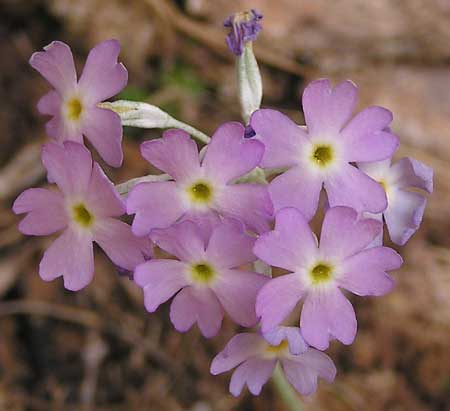Primula
|
Family: Primulaceae |
Herbs perennial [annual], (evergreen and semiwoody in P. suffrutescens), rarely mat-forming (P. suffrutescens; sometimes stoloniferous in P. nutans), slightly to moderately succulent. Rhizomes present, roots fibrous. Stems (scapes) ascending, simple. Leaves in single rosette (multiple rosettes in P. suffrutescens), simple; petiole absent or obscure, winged or not; blade linear, broadly lanceolate, oblanceolate, oblong-obovate, rhombic, or elliptic to cuneate or spatulate, base tapered or rounded and abruptly narrowed, margins entire, dentate, or denticulate, apex toothed, acute, obtuse, rounded, or spatulate, surfaces glabrous or rarely hairy (P. veris), hairs simple. Inflorescences umbels, 2-25+-flowered, involucrate, [racemes or spikes] or solitary flowers; bracts 1-5. Pedicels erect, spreading, arching, nodding, arcuate, or slightly reflexed. Flowers often heterostylous, sometimes homostylous; sepals 5, green, calyx broadly campanulate to cylindric or urceolate, ± 5-angled, weakly keeled or not keeled, glabrous, pilose, or puberulent, lobes not reflexed, length 0.5-1 times tube; petals 5, lavender, magenta, pink, rose, violet, white, or yellow [red], corolla campanulate, lobes not reflexed, length 1-2 times tube, apex rounded; stamens included; filaments distinct; anthers connivent. Capsules globose, cylindric, or ellipsoid, valvate, dehiscent to 1/3 length. Seeds 10-100+, brown, ovoid or oblong, somewhat 4-angled, reticulate or vesiculate. x = [8,] 9, [10,] 11, [12]. Primula is widely distributed throughout Asia and Europe and has comparatively few representatives in North America. Relatively few taxa are circumboreal or widespread in Eurasia; most species of Primula have relatively restricted ranges. Certain geographic areas, e.g., the Himalayas and the European Alps and certain sections of the genus are remarkable for the many narrowly endemic taxa they encompass. Systematic treatments of Primula have been based on multiple aspects of cytology, anatomy, morphology, and, more recently, molecular studies, which provide a foundation for division of the genus into well-defined sections, five of which occur in North America. Although sections are relatively discrete in Primula, specific and infraspecific delineation has been less distinct due to morphological plasticity. Primula species are best distinguished with a combination of characteristics rather than a single diagnostic attribute.
FLOWERS: variously colored; calyx deeply lobed, the lobes 5, persistent in fruit; corolla lobed no more than ½ its length, the 5 lobes spreading 90 to the tubular portion, the apices retuse to emarginate; stamens 5, generally attached to the upper portion of the corolla tube; style generally shorter than the corolla tube; ovary superior. PLANT: Perennials, generally herbaceous with upright stems. LEAVES: generally basal; margins dentate, sinuate, or entire. INFLORESCENCE: a scapose umbel. FRUITS: valvate. NOTES: 200 spp. of north temperate regions. (Latin: first, from early flowering). Williams, L. O. 1936. Amer. Midl. Naturalist 17:741-748. REFERENCES: Cholewa Anita F. 1992. Primulaceae. Ariz.-Nev. Acad. Sci. 26(1)2. Cal campanulate to tubular, 5-lobed, persistent; cor funnelform or salverform, the tube longer than the cal (in our spp.), the lobes retuse or 2-lobed; stamens included, borne on the cor-tube; filaments very short; capsule 5-valved at the tip; scapose perennials, the often large and showy fls in a terminal umbel or head, or in successive whorls on the lfless scape, and subtended by small or leafy bracts. 200, N. Hemisphere.
In addition to the following spp., P. veris L., the English cowslip, with yellow fls and somewhat inflated cal, occasionally escapes in the n. part of our range. Gleason, Henry A. & Cronquist, Arthur J. 1991. Manual of vascular plants of northeastern United States and adjacent Canada. lxxv + 910 pp. ©The New York Botanical Garden. All rights reserved. Used by permission. |

